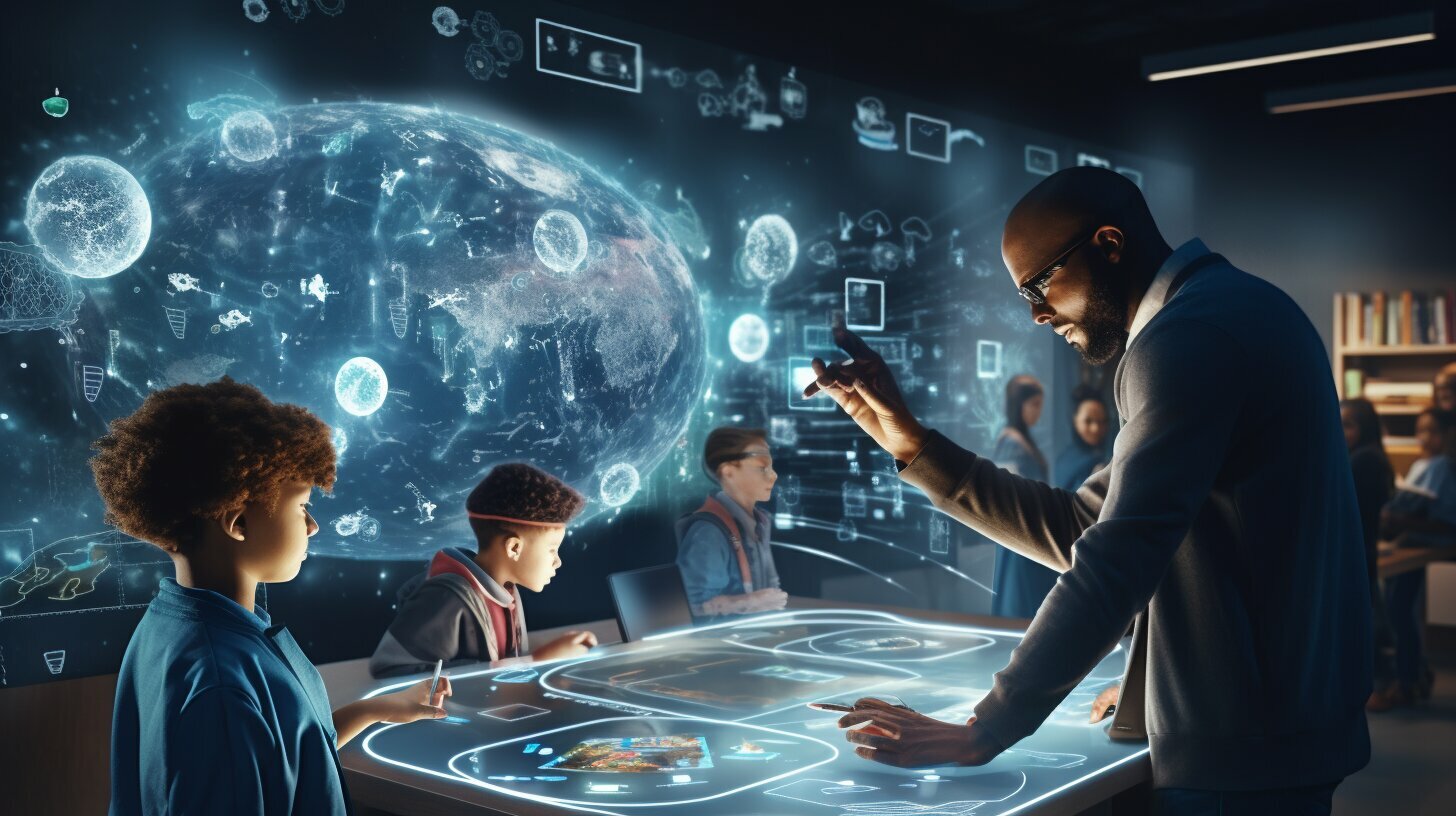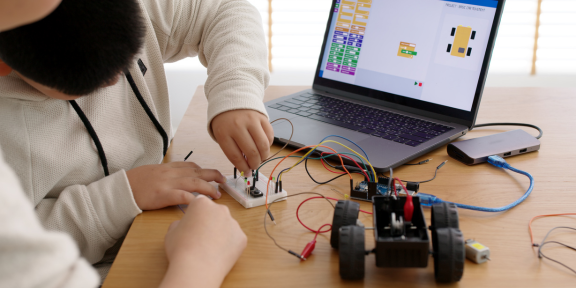The Impact of AI in Education: Revolutionizing Learning

In the coming years, the field of education will witness a significant transformation with the integration of artificial intelligence (AI) technology. AI can revolutionize the way we approach learning, enabling personalized and adaptive experiences for students while enhancing teaching methods and facilitating access to digital resources. AI in education has the potential to shape the future of classrooms, offering unparalleled opportunities for growth and innovation. In this article, we will explore the impact of AI in education, its applications, benefits, and potential future trends.
Just to be clear, we do not believe that AI will be replacing teachers. The human touch from preschool through graduate school is needed to helps guide students. AI and emerging technologies will enhance learning and hopefully give teachers a helping hand so they have more time to spend with students.
Understanding AI in Education
Artificial intelligence, or AI for short, is a term used to describe the simulation of human intelligence in machines that are trained to learn and make decisions based on data. In the field of education, AI technology is transforming the way students learn and teachers teach.
AI is being used in a variety of ways in the classroom, from personalized learning experiences to enhancing teaching methods. One of the most significant benefits of educational AI is its ability to adapt to the individual needs and abilities of each student, providing a tailored learning experience for optimal engagement and retention.
What is AI?
At its core, generative AI is a technology that enables machines to learn through data analysis, without being specifically programmed to do so. It involves the use of algorithms and computer models that can recognize patterns and make predictions based on the data they are processing. This ability to learn and adapt makes AI a valuable tool in education, where personalized learning and adaptive teaching methods are becoming increasingly important.

Personalizing Learning with AI
Artificial Intelligence is making it possible to provide personalized learning experiences for students. It has the potential to revolutionize the traditional “one-size-fits-all” approach to education, catering to the individual needs and abilities of each student.
Adaptive learning with AI is being used to create personalized learning paths for students. AI algorithms analyze student data, such as their performance on assessments and their learning style, to create a customized curriculum. This allows students to learn at their own pace, with content tailored to their interests and strengths.
| Benefits of Personalized Learning with AI |
|---|
Improved student learning outcomes: Personalized learning with AI has been shown to improve student performance, with students receiving higher grades and demonstrating deeper understanding of the material. |
Increased engagement: Personalized learning with AI can help keep students engaged by presenting content in a way that is interesting and relevant to their individual interests and abilities. |
More efficient learning: Personalized learning with AI can save time by allowing students to focus on areas where they need the most help, rather than spending time on material they already understand. |
AI-powered virtual assistants are also being used to provide personalized support to students. These assistants can answer student questions, provide feedback on assignments, offer guidance on studying, writing skills and test-taking strategies.
Real-World Examples:
- Carnegie Learning – provides AI-powered adaptive math programs for K-12 students
- Thinkster Math – uses AI to create personalized learning plans for math students
- Squirrel AI Learning – offers an AI-powered tutoring system for K-12 students in China
Overall, the use of AI in education is transforming the way students learn, providing them with personalized learning experiences that improve outcomes, increase engagement, and make learning more efficient.
Enhancing Teaching Methods with AI
Teachers are increasingly using AI applications in their classrooms to enhance traditional teaching methods. AI-powered tools can help teachers create more engaging and personalized learning experiences for their students. Here are a few ways that AI is revolutionizing teaching methods:
AI Application |
Benefits to Teachers |
|---|---|
| Automated grading | Save time and provide faster feedback to students |
| Learning analytics | Track student progress and identify areas that need additional support |
| Intelligent tutoring systems | Provide personalized learning experiences based on student needs and abilities |
With automated grading, teachers can save time and energy by having AI systems grade assignments and provide feedback to students. This allows teachers to focus on other important tasks, such as lesson planning and classroom management.
Learning analytics tools can be used to track student progress and identify areas that need additional support. This can help teachers provide targeted interventions to students who are struggling, and better differentiate instruction to meet the needs of their students.
Intelligent tutoring systems can provide personalized learning experiences based on student needs and abilities. These systems use machine learning algorithms to adapt to each student’s learning pace and style, providing a customized experience that can improve student engagement and outcomes.
Engaging Students with Interactive and Personalized Learning
One of the main benefits of AI in education is that it enables teachers to create more engaging and interactive learning experiences for their students. AI-powered tools can be used to create immersive simulations, interactive games, and virtual field trips that can help students better understand complex concepts and improve their critical thinking skills.
Personalized learning algorithms can also be used to create customized learning plans for each student. These algorithms analyze each student’s strengths, weaknesses, and learning style to create a customized curriculum that can improve student outcomes and engagement.
Overall, AI in education is transforming the way that teachers teach and students learn. By using AI-powered tools and applications, teachers and education leaders can create more efficient, effective, and engaging learning environments for their students, leading to improved student outcomes and a brighter future for education.

The Benefits of AI in Education
Artificial intelligence is revolutionizing education, offering a range of benefits that are enhancing the learning experience for students of all ages. Here are some of the key advantages:
| Better Student Outcomes | AI applications in education are enabling personalized learning experiences, facilitating better understanding and retention of concepts. AI-powered tools are also providing teachers with better insights into student performance, enabling them to provide more targeted support. |
|---|---|
| Increased Efficiency | AI is streamlining administrative processes, such as grading and assessment, freeing up teachers to focus on teaching and engaging with students. Additionally, AI-powered tools are helping to automate routine tasks, such as lesson planning and content creation. |
| Access to Personalized Feedback | AI applications are providing students with access to immediate and personalized feedback on their performance. This helps them to better understand their strengths and weaknesses, and to identify areas for improvement. |
Improved Student Outcomes
“AI is allowing me to cater to each individual student’s needs. The ability to personalize learning is having a direct impact on student performance.” – High School Teacher
One of the biggest advantages of AI in education is the ability to personalize learning experiences. With AI-powered tools, teachers can better understand each student’s learning style and tailor lessons to suit their individual needs. This is particularly beneficial for students who struggle with certain concepts, as it allows them to focus on the areas where they need the most support. AI applications also facilitate better engagement and collaboration in classrooms, as students are able to learn at their own pace and in a way that suits their individual learning styles.
Increased Efficiency
“AI is allowing me to be more efficient with my time, enabling me to focus on the things that matter, like engaging with my students.” – Elementary School Teacher
AI is streamlining administrative processes, such as grading and assessment, freeing up teachers to focus on teaching and engaging with students. Additionally, AI-powered tools are helping to automate routine tasks, such as lesson planning and content creation. This is leading to a more efficient and effective education system, where teachers can deliver a higher quality of education with less time spent on administrative tasks. Wouldn’t it be great for teachers to be able to leave at the end of their day and not have to do more schoolwork?!
Access to Personalized Feedback
“The instant feedback I receive from AI-powered tools is helping me to stay on track and identify areas where I need to improve.” – University Student
One of the major benefits of AI in education is the ability for students to receive immediate and personalized feedback on their work. AI applications are able to analyze student performance and identify areas where they are excelling, as well as areas where they may need additional support. This allows students to better understand their strengths and weaknesses, and to focus on areas where they need to improve. Additionally, this feedback can be provided in real-time, enabling students to make immediate adjustments in their learning approach.
AI-Powered Educational Tools
With the implementation of AI technology in education, various innovative tools have emerged that are changing the way students learn. These tools go beyond traditional methods of teaching and provide interactive and engaging learning experiences for students. Let’s take a look at some of the AI-powered educational tools being used in classrooms:
1. Adaptive Learning Platforms
Adaptive learning platforms use machine learning algorithms to adapt to a student’s learning style, pace, and progress. The platform assesses each student’s strengths and weaknesses and provides personalized feedback and recommendations for improvement. This allows students to learn at their own pace and level, resulting in better retention of knowledge.
2. Virtual and Augmented Reality Tools
AI-driven virtual and augmented reality tools provide immersive learning experiences for students, allowing them to explore and interact with different environments and concepts. The technology creates a “hands-on” approach to learning and makes even the most complex topics easier to understand.
3. Smart Content
Smart content is interactive educational material that uses AI to monitor and adapt to a student’s progress. These tools enable teachers to deliver content in a personalized and engaging way, allowing students to learn and practice concepts in a fun and interactive manner.
4. Chatbots and Intelligent Agents
Chatbots and intelligent agents are AI-powered conversational interfaces that can answer students’ questions, provide feedback, and offer assistance in real-time. These tools enable students to receive personalized help when needed, reducing the need for one-on-one interaction with teachers.
Overall, the use of AI-powered educational tools is transforming the learning experience and allowing students to reach their full potential. These innovative tools are helping to create a more personalized and engaging learning environment, enabling students to succeed in the classroom and beyond.

Machine Learning in Education
Machine learning is a type of artificial intelligence that enables computers to learn and adapt based on data inputs. In the field of education, machine learning technology is being used to improve student outcomes and enhance teaching methods.
Intelligent Tutoring Systems
One of the most promising applications of machine learning in education is the development of intelligent tutoring systems. These systems use algorithms to provide personalized feedback and guidance to students, helping them understand complex concepts and improve their performance.
Intelligent tutoring systems can analyze student data, such as their learning preferences and performance history, to adapt the course material and provide tailored recommendations. This approach can help students stay engaged and motivated, while also improving their overall learning outcomes.
Predictive Analytics
Another way machine learning is being used in education is through predictive analytics, which involves analyzing large amounts of data to identify patterns and predict future outcomes. In the context of education, predictive analytics can help educators identify at-risk students and intervene before they fall behind.
For example, predictive analytics can be used to analyze student performance data and identify patterns of behavior that are correlated with poor academic performance. Educators can then use this information to create targeted interventions and support programs to help those students succeed.
Virtual Classrooms
Machine learning is also being used to support the development of virtual classrooms, which are online learning platforms that enable students to participate in real-time classroom discussions and activities. These platforms use machine learning algorithms to facilitate personalized learning experiences, adaptive assessments, and real-time feedback.
Virtual classrooms are particularly useful for students who are unable to attend traditional classes due to geographical or logistical constraints. They also offer a flexible learning environment, enabling students to learn at their own pace and on their own schedule.
Digital Learning with AI
A growing number of educators are turning to digital learning as a means of enhancing the educational experience. With the advent of AI, platforms and tools can now be personalized to meet the unique needs of each learner, regardless of their location or device.
AI can also help to democratize access to education, by providing low-cost or free resources to those who might not otherwise have access to traditional learning environments. This has the potential to drive greater diversity and inclusivity in education, enabling learners from all backgrounds to realize their full potential.
One key area where AI is proving especially beneficial is in the creation of adaptive learning environments. By analyzing the unique learning styles and preferences of individual users, AI algorithms can tailor content, tasks, and feedback to suit their specific needs. This not only improves the overall quality of the learning experience but also saves educators time and effort in tracking and assessing student progress.
As digital learning continues to evolve, we can expect to see even more innovative applications of AI in education. From interactive chatbots and virtual classrooms to augmented reality simulations and gamification, the possibilities are truly endless.
- Example: Some schools have already begun experimenting with VR to provide immersive educational experiences in subjects such as science, history, and geography. Students can explore ancient ruins, visit distant planets, or interact with lifelike simulations of historical events, all from the comfort of their own classroom.

Shaping Future Classrooms with AI
The role of AI in education is constantly evolving and expanding, and its potential impact on future classrooms is vast. Here are some of the trends and developments that could shape the future of learning:
Virtual and Augmented Reality
Virtual and augmented reality technologies offer exciting possibilities for immersive learning experiences. With AI-powered virtual and augmented reality tools, students can explore historical sites, scientific phenomena, and even other planets. This technology can help bring complex concepts to life, engage students in interactive learning, and create a more dynamic classroom environment.
Personalized Learning Algorithms
AI algorithms are being developed to create even more personalized learning experiences for students. By analyzing vast amounts of data on student performance and behavior, these algorithms can identify patterns and make predictions about what each student needs to learn and how they learn best. This could lead to more efficient and effective education, with students receiving tailored instruction and feedback based on their unique strengths and weaknesses.
Smart Devices
The growth of the Internet of Things (IoT) means that more and more devices can be connected to the internet and each other. In the classroom, this could mean smart whiteboards, desks, or even wearables that track student activity and offer personalized recommendations. These devices could also help teachers manage classroom logistics, such as taking attendance or monitoring students’ progress on assignments.
Intelligent Tutoring Systems
Intelligent tutoring systems use AI to offer personalized instruction and support to students. By analyzing student data and tracking progress, these systems can adapt to each student’s unique needs and provide tailored feedback and guidance. This could help bridge gaps in knowledge and lead to more engaged and successful learning experiences for students.
Adaptive Learning Platforms
Adaptive learning platforms use AI to analyze student data and create custom curriculums for each student. These platforms can adapt to each student’s learning pace and style, ensuring that they are challenged but not overwhelmed. By providing personalized content and assessments, these platforms could help students learn more efficiently and effectively.
As these and other AI technologies continue to develop and improve, the future of education looks increasingly personalized, engaging, and efficient. However, it is important to remember that AI is a tool, and it is up to educators and administrators to use it responsibly and in the best interests of students.
Wrap Up
In conclusion, AI has the potential to profoundly impact the field of education by revolutionizing the learning experience for students and enhancing teaching methods. The integration of AI technology offers personalized and adaptive learning experiences, improved student outcomes, increased engagement, and more efficient learning.
AI-powered tools and applications provide teachers with valuable support, saving time on administrative tasks and allowing them to focus on personalized instruction. As AI continues to evolve, we can expect to see even more innovative applications in the future, such as virtual and augmented reality, intelligent tutoring systems, adaptive learning platforms, and smart devices.
While AI will never replace the important role of teachers, it has the potential to greatly enhance education by creating more personalized, engaging, and efficient learning environments.
How are you using AI in education? What cool things have you been doing or tools have you been using? Let us know in the comments below.

Frequently Asked Questions AI In Education
As AI continues to rise as an increasingly important role in education, many individuals may have questions about how it works and what it means for the future. Here are some frequently asked questions about AI in education:
What is AI?
AI, or artificial intelligence, refers to the ability of machines to mimic human intelligence and perform tasks that normally require human intelligence, such as speech recognition, decision-making, and problem-solving.
How is AI being used in education?
AI is being used in a variety of ways in education, such as enabling adaptive learning experiences, providing personalized feedback to students, improving teaching methods, and facilitating access to digital resources and remote learning opportunities.
What are the benefits of using AI in education?
Some of the benefits of using AI in education include improved student outcomes and engagement, increased efficiency and effectiveness of teaching methods, and access to personalized feedback and learning opportunities.
What are some examples of AI-powered educational tools?
Some examples of AI-powered educational tools include ways to create ai systems for intelligent tutoring systems, learning management systems, automated grading and assessment tools, and predictive analytics software.
What is machine learning and how is it being used in education?
Machine learning refers to the ability of machines to learn and improve their performance based on data and feedback. In education, machine learning is being used to develop intelligent tutoring systems, adaptive learning algorithms, and predictive analytics tools to assist educators in identifying at-risk students and developing personalized learning plans.
What is the future of AI in education?
The future of AI in education is likely to involve further integration of digital technologies, such as virtual and augmented reality, into learning environments, as well as the development of more advanced AI-powered educational tools and algorithms that can personalize learning experiences even further.
Is AI going to replace teachers?
No, AI is not going to replace teachers. While AI can assist teachers in developing personalized learning plans and providing feedback to students, it cannot replace the human element of teaching and the unique insights and experiences that human teachers bring to the classroom.
How can educators prepare for the use of AI in the classroom?
Educators can prepare for the use of AI in the classroom by crossing the digital divide and staying up to date on developments in the field, exploring AI-powered educational tools and new technologies, and working to develop their own digital literacy and technology skills.
Key Takeaways
- AI technology is transforming education by personalizing learning experiences for students and enhancing teaching methods.
- AI in education adapts to individual needs and abilities, providing tailored learning experiences for optimal engagement and retention.
- Personalized learning with AI improves student learning outcomes, increases engagement, and saves time by focusing on areas that need the most help.
- AI-powered virtual assistants provide personalized support to students, answering questions and offering guidance.
- AI applications in teaching methods include automated grading, learning analytics, and intelligent tutoring systems.
- AI-powered tools create more engaging and interactive learning experiences for students.
- AI in education enhances student outcomes, increases efficiency, and provides personalized feedback.
- AI-powered educational tools include adaptive learning platforms, virtual and augmented reality tools, smart content, and chatbots.
- Machine learning in education enables intelligent tutoring systems, predictive analytics, and virtual classrooms.
- Digital learning with AI offers personalized and inclusive education opportunities.
- Future trends in AI in education include virtual and augmented reality, personalized learning algorithms, smart devices, intelligent tutoring systems, and adaptive learning platforms.
- AI will not replace teachers but will enhance their role by providing personalized support and insight.
- Educators can prepare for the use of AI by staying up to date on developments, exploring AI-powered tools, and developing
